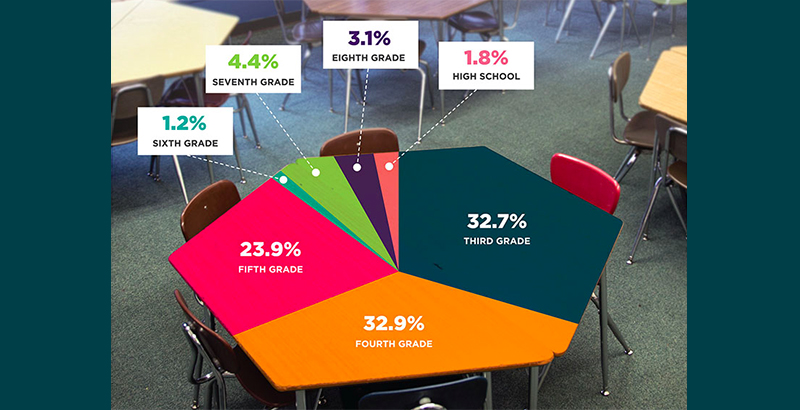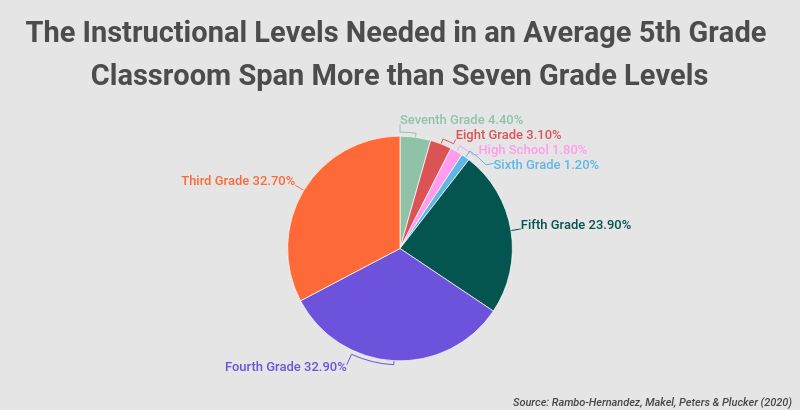New Research Predicts Steep COVID Learning Losses Will Widen Already Dramatic Achievement Gaps Within Classrooms

As they attempt to plan for anticipated student learning losses next year, teachers and school administrators need to prepare for an additional pandemic-related challenge: Students in individual classrooms are likely to show up with a dizzyingly wide range of academic abilities.
Before pandemic-related school closures, a single classroom could have students working at up to seven grade levels. New research conducted by the nonprofit assessment organization NWEA predicts that teachers are likely to see an even broader array of achievement gaps when schools reopen.
Although the researchers can’t project how many grade levels might be represented in the average classroom at the start of the next academic year, they say the number of students at the extremes is likely to grow. The lowest-achieving kids may fall two more years behind.
The researchers, working in conjunction with Texas A&M, Johns Hopkins and Duke universities and the University of Wisconsin-Whitewater, arrived at the prediction using data from schools in the 10 states with the highest participation in NWEA’s MAP assessment, formerly known as the Measures of Academic Progress. Of 375,000 fifth-graders in those states in 2016, one-third scored at or below third grade in math, one-third at fourth grade, one-fourth at fifth and 10 percent above grade level, according to Karen Rambo-Hernandez, an associate professor at Texas A&M’s College of Education and Human Development.

In reading, at the beginning of fifth grade, just 14 percent of students performed at grade level. One-third were reading beyond grade level and half below. Third grade is the lowest threshold the researchers can measure, so it’s possible some students may be even more grades behind.
“All of this is in a typical year,” notes Rambo-Hernandez. “Next year is not going to look like a typical year.”
In April, NWEA’s Collaborative for Student Growth Research Center released research suggesting that on average, students next fall are likely to retain about 70 percent of this year’s gains in reading and less than 50 percent in math. Losses are likely to be more pronounced in the early grades, when students normally acquire many basic skills, and among those already facing steep inequities.
Given the data on learning losses, Rambo-Hernandez says it’s possible the array of abilities in a classroom in a normal year will widen by two or more grades in the fall. Children who have been historically underserved are at high risk of falling further behind, while high-achieving kids, allowed to work at their own pace with lots of resources, may rocket ahead.
Effectively reaching all students with such varied learning needs — including children in special education and English learners — in a single classroom is a huge challenge under any circumstances. But now, especially without spring exams to guide them, schools will have no idea on day one of the 2020-21 school year what the array of needs in each class is.
Is it possible to teach such a varied group of students, either physically in a classroom or online? Yes, but it’s no mean feat, says Julia Kaufman, a senior policy researcher at the RAND Corp.
Differentiation, the process of tailoring instruction for children with varying levels of achievement, was already a major challenge for teachers who had to modify curricula that didn’t meet their students’ needs.
In surveys conducted in February 2015, teachers told RAND that their top need was training on differentiation. According to a 2019 RAND survey, the vast majority of teachers modify lessons at least once a week. Depending on the subject and type of student need, Kaufman says, 20 percent to 30 percent modify what they teach nearly every lesson.
Add to this the possibility that teachers will be attempting to address a broader array of needs in a remote setting. “Differentiation when you’re in the classroom physically is one thing,” says Kaufman. “I don’t know how you do it looking at faces on Zoom.”
A professional development specialist with NWEA, Fenesha Hubbard counsels a combination of determination and careful planning, ideally with high-quality data and in teams. “In addition to self-care, teachers need to get clear on where they stand,” she says. “Students can pick up on whether educators are not fully invested. Do you actually believe that your students are all going to show up and be successful in this environment?”
And as uncomfortable as it is, especially when teachers are being asked to stretch in ways previously unimagined, it’s time to ask why students are arriving with such a diverse array of past learning, she says.
Solid data about the specific concepts each student does or doesn’t understand will be crucial. Teachers know how to check for understanding when physically present in the classroom but are going to need new strategies next year, she says: “How do you get that data from students in a virtual environment?”
Some online platforms incorporate tools that allow teachers to gather responses, for example. Or perhaps students can text their answers. Teachers should figure out what data their colleagues are collecting and how. Whether teachers collaborate online or in person, planning meetings now need to have data and formal agendas to outline the data’s use, she says.
“The way we use minutes in school is changing,” says Hubbard. “You’re probably not going to be with your students for six hours in a virtual room. This is an opportunity for teachers to carve out time to work with individual students.”
Get stories like these delivered straight to your inbox. Sign up for The 74 Newsletter

;)
